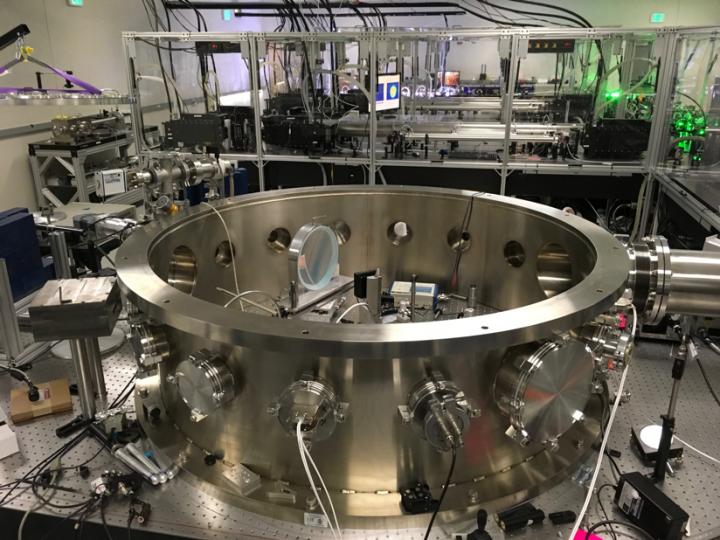Laser-heated nanowires produce micro-scale nuclear fusion

This is the target chamber (front) and ultra-high intensity laser (back) used in the micro-scale fusion experiment at Colorado State University Credit: Advanced Beam Laboratory/Colorado State University
Nuclear fusion, the process that powers our sun, happens when nuclear reactions between light elements produce heavier ones. It's also happening – at a smaller scale – in a Colorado State University laboratory.
Using a compact but powerful laser to heat arrays of ordered nanowires, CSU scientists and collaborators have demonstrated micro-scale nuclear fusion in the lab. They have achieved record-setting efficiency for the generation of neutrons – chargeless sub-atomic particles resulting from the fusion process.
Their work is detailed in a paper published in Nature Communications, and is led by Jorge Rocca, University Distinguished Professor in electrical and computer engineering and physics. The paper's first author is Alden Curtis, a CSU graduate student.
Laser-driven controlled fusion experiments are typically done at multi-hundred-million-dollar lasers housed in stadium-sized buildings. Such experiments are usually geared toward harnessing fusion for clean energy applications.
In contrast, Rocca's team of students, research scientists and collaborators, work with an ultra fast, high-powered tabletop laser they built from scratch. They use their fast, pulsed laser to irradiate a target of invisible wires and instantly create extremely hot, dense plasmas – with conditions approaching those inside the sun. These plasmas drive fusion reactions, giving off helium and flashes of energetic neutrons.
In their Nature Communications experiment, the team produced a record number of neutrons per unit of laser energy – about 500 times better than experiments that use conventional flat targets from the same material. Their laser's target was an array of nanowires made out of a material called deuterated polyethylene. The material is similar to the widely used polyethylene plastic, but its common hydrogen atoms are substituted by deuterium, a heavier kind of hydrogen atom.
The efforts were supported by intensive computer simulations conducted at the University of Dusseldorf (Germany), and at CSU.
Making fusion neutrons efficiently, at a small scale, could lead to advances in neutron-based imaging, and neutron probes to gain insight on the structure and properties of materials. The results also contribute to understanding interactions of ultra-intense laser light with matter.
###
The paper is titled “Micro-scale fusion in dense relativistic nanowire array plasmas.” The research was supported by the Air Force Office of Scientific Research and by Mission Support Test Services, LLC.
Media Contact
All latest news from the category: Physics and Astronomy
This area deals with the fundamental laws and building blocks of nature and how they interact, the properties and the behavior of matter, and research into space and time and their structures.
innovations-report provides in-depth reports and articles on subjects such as astrophysics, laser technologies, nuclear, quantum, particle and solid-state physics, nanotechnologies, planetary research and findings (Mars, Venus) and developments related to the Hubble Telescope.
Newest articles

Sea slugs inspire highly stretchable biomedical sensor
USC Viterbi School of Engineering researcher Hangbo Zhao presents findings on highly stretchable and customizable microneedles for application in fields including neuroscience, tissue engineering, and wearable bioelectronics. The revolution in…

Twisting and binding matter waves with photons in a cavity
Precisely measuring the energy states of individual atoms has been a historical challenge for physicists due to atomic recoil. When an atom interacts with a photon, the atom “recoils” in…

Nanotubes, nanoparticles, and antibodies detect tiny amounts of fentanyl
New sensor is six orders of magnitude more sensitive than the next best thing. A research team at Pitt led by Alexander Star, a chemistry professor in the Kenneth P. Dietrich…





















